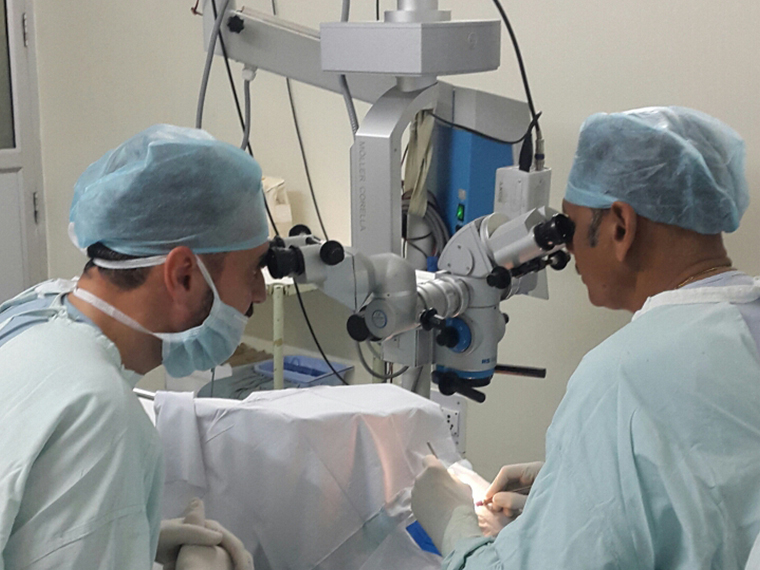Hey there! If you’ve recently undergone phaco eye surgery, first of all, congratulations on taking a step towards better vision! We know that recovering from any surgery can be a bit daunting, but fear not, because we’ve got your back. In this ultimate guide, we’ll walk you through everything you need to know about recovering after phaco eye surgery. From the first few hours post-surgery to the weeks that follow, we’ll cover all the dos and don’ts, share tips and tricks to make your recovery smoother, and answer any questions you might have along the way. So, put your feet up, grab a cup of tea, and let’s dive into this comprehensive guide to help you breeze through your recovery period after phaco eye surgery!
What is Phaco Eye Surgery?
Phacoemulsification, commonly known as phacoeye surgery, is a highly effective and widely practiced procedure aimed at improving vision by replacing the natural lens of the eyes with a synthetic lens. This remarkable surgical technique has revolutionized the treatment of various vision problems, particularly those caused by conditions like common forms of visual impairment such as refractive errors due to nearsightedness or astigmatism and the more severe condition of clouded vision caused by the formation of a dense, opaque layer known as a Cataract. By removing the clouded natural lens through ultrasonic vibrations and replacing them with an artificial lens, phaco surgery offers individuals suffering such vision impairments a chance to regain clear and sharp eyesight, thereby significantly improving their quality of life. This minimally invasive procedure has gained immense popularity owing to its high success rate, shorter recovery time, and reduced risk of complications, making phacoeye surgery a preferred choice for many patients seeking visual correction.
Phacoeye surgery, also known as phacoemulsification, is a modern and minimally invasive procedure used to treat various vision impairments. The procedure specifically targets the natural lens of the patient’s eyes, which is causing the vision problem. By making a small incision in the cornea, the surgeon gains access to the affected lens. This incision is crucial as a small ultrasonic device is then skillfully inserted into the patient’s eyes. The device plays a pivotal role in breaking up the old lens, fragmenting and emulsifying its components. With increased precision and efficiency, the fragmented lens is subsequently removed, seamlessly paving the way for a new and artificial lens. Phacoeye surgery offers patients a chance to restore their vision while minimizing any potential risks and complications associated with traditional surgical methods. The procedure’s gentle approach and advanced technology make phacoeye surgery an increasingly popular choice for those seeking improved visual acuity.
Phacoemulsification, commonly known as phaco, is a revolutionary technique used in modern ophthalmology to treat a variety of vision impairments. During this delicate procedure, a small incision is made in the cornea, allowing access to the lens. The surgeon then utilizes ultrasound waves to break down the cloudy or damaged natural lens, making space for the new synthetic lens to be inserted. Carefully aligning the artificial lens, the surgeon ensures that its position corresponds to the patient’s unique visual needs. To secure the lens in place, a specialized material is applied, providing stability and support. This meticulous process guarantees that the lens remains in position, enabling optimal vision correction. Finally, a protective shield is cautiously placed over the patient’s treated eyes for a few days to facilitate healing and alleviate any discomfort. Phacoeye surgery combines cutting-edge technology with skilled expertise to restore clear vision and improve one’s overall quality of life.
Additionally, phacoemulsification surgery has been proven to be a highly effective and safe procedure for individuals seeking to improve their vision. Along with the convenience of not having to rely on glasses or contact lenses, many patients experience a significant improvement in their overall quality of life. However, prior to making a decision about undergoing phacoemulsification surgery, discussing the potential risks and benefits with your doctor is essential. This will ensure that you have a clear understanding of the procedure and can make an informed decision that is right for you and your specific visual needs. So, take the first step towards a clearer future and consult with your doctor today.
Preparing for the Surgery
Preparing for phaco eye surgery is crucial to achieve the most favorable outcome. This procedure requires thorough preparation, and your eye doctor plays a pivotal role in guiding you through the necessary steps. They will provide you with comprehensive instructions specifically tailored to phaco eye surgery. These instructions may include vital details about the medications you should take or avoid prior to the procedure. Additionally, your doctor may also offer advice regarding any dietary and lifestyle modifications that might be essential for a successful surgery. By following these guidelines diligently, you can optimize your chances of a positive outcome in the realm of phaco eye surgery.
When considering a medical procedure like phaco eye surgery, it is crucial to be well-informed about the potential risks involved. Phaco eye surgery is a commonly performed procedure to remove cataracts and restore vision. However, it is essential for patients to have a clear understanding of the process and any potential complications before undergoing the surgery. To ensure peace of mind, it is highly recommended to have an open and thorough discussion with your surgeon regarding any concerns or questions you may have about phaco eye surgery. By communicating your worries ahead of time, your surgeon can address them adequately, providing you with the necessary reassurance and confidence in the procedure.
However, it is crucial to remember that the success of the phaco eye surgery not only depends on the expertise of the surgeon but also on your compliance with the instructions provided by your doctor. By diligently attending all pre-operative exams and appointments, you allow your doctor to thoroughly assess your eye health and make necessary adjustments to the surgical plan. Moreover, following the instructions for cleaning and prepping your eyes before the surgery helps create a sterile environment, reducing the risk of infection or complications during the procedure. By adhering to these directions, you actively participate in ensuring a safe and successful operation, leading to improved vision and a positive outcome.
What to Expect During Your Surgery
Before your phaco eye surgery, you will likely undergo a pre-operative evaluation to ensure that you are an ideal candidate for the procedure. This evaluation is crucial in determining if you have any underlying conditions or factors that may pose risks or affect the success of the surgery. In this assessment, your eye doctor will thoroughly examine your eyes, checking for any pre-existing eye conditions, such as cataracts or glaucoma, which could impact the surgical outcome. They will also evaluate your overall health and medical history to identify any potential contraindications or complications during the surgery. This comprehensive evaluation is carried out with utmost care and professionalism to ensure that you receive the best possible treatment for your specific needs. By conducting this pre-operative assessment, your medical team can ensure that you receive the most appropriate and effective phaco eye surgery, tailored to your individual circumstances.
During a phaco eye surgery, the patient’s comfort is of utmost importance. Hence, anesthesia will be administered to ensure a pain-free experience. This procedure involves the skillful hands of the doctor who will make a minuscule incision in the eye. This incision grants access to the lens, which is the focal point of the surgical intervention. These steps represent the crucial aspects of a phaco eye surgery, where precision and care are ensured to achieve the best possible outcomes for patients.
In phaco eye surgery, the procedure begins with the creation of a small incision on the surface of the eye. This is followed by the insertion of a delicate and slender probe through the incision. The purpose of this probe is to carefully break up and eliminate the natural lens of the eye, allowing for the subsequent insertion of an artificial intraocular lens (IOL). This sophisticated technique, known as phacoemulsification, involves the utilization of ultrasonic waves to fragment and remove the lens, thus minimizing the invasiveness of the surgery. The use of an artificial IOL ensures that the patient’s vision is properly restored, providing them with improved visual clarity and functionality. Overall, phaco eye surgery presents a significant advancement in ophthalmic technology, offering patients a safe and effective procedure with a faster recovery time.
Additionally, phaco eye surgery has proven to be a highly effective and safe procedure for treating cataracts. The use of sutures to close the incision not only ensures proper healing but also minimizes the risk of infection. Your doctor will closely monitor you after the surgery to check for any potential side effects or complications. With advancements in technology and surgical techniques, phaco eye surgery has become an increasingly popular and reliable choice for individuals seeking clearer vision and improved quality of life.
Post-Surgery Care Instructions
Phaco eye surgery, also known as phacoemulsification, is a crucial procedure that requires proper care and attention for a successful surgery and quick recovery. Once the surgery is complete, it is imperative to adhere to the doctor’s post-surgery care instructions meticulously. These instructions serve as a guiding light to ensure the best possible outcome. By following these guidelines, patients significantly increase their chances of a favorable recovery. This includes diligently following the recommended medication schedule, attending all postoperative appointments, and taking any prescribed eye drops or medications as directed. Additionally, patients should avoid activities that could strain or irritate their eyes, such as heavy lifting or rubbing the eyes for an extended period. Complying with these precautions not only aids in a speedy recovery but also reduces the risk of complications such as infection or further damage to the eye. By prioritizing one’s health and implementing these necessary measures, patients can optimize their healing process and regain visual clarity as soon as possible.
When it comes to recovering from phaco eye surgery, there are several crucial instructions you need to follow in order to ensure a successful outcome. These instructions will encompass various aspects, such as the usage of eye drops and eye ointment. It is vital to adhere to the prescribed schedule for applying these medications, as they are crucial for the healing process and preventing any potential complications. Additionally, regular follow-up visits will be necessary to monitor your progress and make any necessary adjustments to your treatment plan. These visits will help your healthcare provider assess your eye health and make sure that you are recovering well. Moreover, it is important to keep in mind certain restrictions on physical activities during the recovery period. Engaging in rigorous activities or exercises can put unnecessary strain on your eyes and compromise the healing process. By following these restrictions, you can assist in facilitating a smooth recovery and minimize any potential risks or complications. Therefore, it is crucial to carefully adhere to these instructions and maintain open communication with your healthcare provider throughout your recovery journey.
However, it is crucial to adhere to these instructions diligently, as they play a pivotal role in safeguarding the eye from potential complications that might arise after phaco eye surgery. Following the prescribed guidelines can significantly reduce the risk of infection or any other form of damage, ultimately ensuring the long-term health and well-being of the eye. Neglecting these essential instructions could have detrimental effects on the healing process and compromise the overall success of the surgery. Therefore, by conscientiously following the recommended post-surgery care, individuals can effectively protect their eyes and maximize the benefits of phaco eye surgery for years to come.
Managing Your Pain After Surgery
Phaco eye surgery, also known as phacoemulsification, is a common procedure used to remove a cloudy lens from the eye and replace it with an artificial lens. It is a highly effective surgery, but it is not without its discomforts. Pain after phaco eye surgery, while common, can vary from mild discomfort to more intense pain. However, it is crucial to proactively manage this pain in order to ensure a speedy and effective recovery. By taking the necessary steps to relieve and control pain, patients can experience a smoother healing process following phaco eye surgery.
Phaco eye surgery is a common procedure used to treat various eye conditions, including the removal of a cloudy lens or correction of vision problems. After undergoing this surgery, it is crucial to follow your doctor’s instructions for a smooth recovery. Taking pain medications as prescribed by your doctor can greatly help alleviate any discomfort that may be experienced following phaco eye surgery. These medications are specifically designed to minimize pain and promote healing. Alongside medication, it is equally important to adhere to the prescribed schedule for taking these painkillers. Your doctor will provide you with clear instructions on when and how often you should take the medication to effectively manage any post-operative discomfort. By closely following your doctor’s guidance, you can ensure a successful recovery and regain optimal vision after phaco eye surgery.
After undergoing phaco eye surgery, it is essential to maintain proper hygiene and care for the area around your eyes. Keeping this region clean and dry is crucial in preventing any additional irritation or inflammation that may arise. This will promote a smooth healing process and reduce discomfort. Additionally, applying a cold compress or a warm washcloth to the operated area can provide soothing relief from pain and effectively reduce swelling. By incorporating these simple yet effective measures into your post-operative routine, you can ensure a comfortable recovery and successful outcome from phaco eye surgery.
Similarly, if you are still experiencing pain after following the aforementioned steps following phaco-eye surgery, it is crucial to seek guidance from your doctor. Consulting with your doctor will not only allow them to assess the situation accurately but also determine whether additional care is required or if alternative treatments could potentially alleviate your discomfort. Your doctor’s expertise and knowledge in the field of phaco-eye surgery will enable them to provide you with personalized advice and recommendations tailored specifically to your needs. Remember, your health and well-being are of utmost importance, and your doctor is there to guide you on your journey towards a pain-free recovery.
Recovery Tips and Exercises
Recovery from phaco eye surgery plays a crucial role in achieving the best possible outcome for patients. To ensure a smooth recovery, it is imperative to carefully adhere to the instructions provided by the doctor. This may involve diligently taking the prescribed medications and allowing oneself ample time to rest. By following these guidelines, patients can positively contribute to their healing process, allowing their eyes to heal effectively and efficiently. Adhering to post-surgery protocols is essential for minimizing any potential complications or setbacks. Therefore, it is highly recommended to prioritize following medical advice for a successful recovery after phaco eye surgery.
Phaco eye surgery, a common procedure used to remove a cloudy lens and replace it with an artificial one, can greatly improve vision for individuals with various eye conditions. However, the recovery process after the surgery is crucial for ensuring optimal results. In addition to following post-operative instructions provided by the surgeon, engaging in gentle eye exercises can play a significant role in strengthening the eye muscles and promoting further healing. These exercises, which should be done regularly, are designed to gradually improve eye coordination and flexibility. It is important, however, to avoid overexertion that could strain the eyes. By incorporating these gentle eye exercises into your recovery routine, you can aid in the healing process and potentially enhance the overall outcome of your phaco eye surgery.
When recovering from phaco eye surgery, it is important to take certain precautions to ensure a smooth healing process. To help reduce recovery time and promote the healing of the eyes, it is advised to avoid activities that strain the eyes, such as prolonged staring at computer screens or reading for extended periods of time. These activities can put unnecessary stress on the eyes, potentially prolonging the recovery period. Additionally, it is recommended to steer clear of activities like swimming or any other water-related activities where dirty or contaminated water may come into contact with the eyes. This is crucial to prevent any risk of infection or further damage to the delicate post-surgery eyes. By following these guidelines and taking proper care, the recovery process after phaco eye surgery can be more effective, allowing patients to regain their vision and resume their normal activities sooner.
Thereafter, it is crucial to prioritize the proper lubrication of the eyes with artificial tears before and during any activity associated with eye recovery or exercise, especially after phaco eye surgery. By taking this precautionary measure, individuals can ensure that their eyes are protected from potential irritation and discomfort. Additionally, the consistent use of artificial tears throughout the exercise session will contribute to the healing process of the surgical site. This diligent approach demonstrates a responsible commitment to one’s eye health and overall well-being. Therefore, it is imperative to remember the importance of utilizing artificial tears as part of a comprehensive post-operative care routine in order to promote a successful recovery after phaco eye surgery.
Avoiding Complications After Eye Surgery
Phaco eye surgery, also known as phacoemulsification, is a crucial procedure that aims to treat cataracts and restore clear vision. However, to ensure the overall success of this surgery, it is imperative to follow specific guidelines and precautions in order to avoid potential complications, particularly the risk of infection. By taking the necessary steps post-surgery, such as adhering to strict hygiene practices, consistently administering prescribed medications, and attending regular check-ups with your ophthalmologist, you can greatly reduce the chances of developing any post-operative infections. These preventative measures are crucial in maintaining your eye health and allowing for a smooth recovery following phaco eye surgery.
When it comes to phaco eye surgery, minimizing the risk of infection is of utmost importance. In order to ensure a smooth recovery, it is crucial to closely adhere to the instructions provided by your doctor regarding post-operative care. This includes diligently cleaning the eye as directed and using the prescribed eye drops or ointments. These specific measures, recommended by medical professionals in the field, play a vital role in preventing potential infections and promoting optimal healing. By following these guidelines, patients can confidently take control of their own well-being and significantly contribute to a successful outcome of their phaco eye surgery.
Moreover, it is crucial to prioritize regular follow-up visits with your doctor after undergoing phaco eye surgery. These appointments are essential not only to monitor the healing process but also to detect any potential signs of infection or other complications that could impede your recovery. By staying committed to these check-ups, you can ensure that your eyes are healing properly and address any issues promptly, thereby maximizing the success of your surgery. Additionally, your doctor will provide you with personalized instructions and advice to further aid in your recovery and optimize your visual outcomes. Remember, the key to a successful phaco eye surgery is not just the procedure itself but also diligent post-operative care. So, make it a priority to schedule and attend these follow-up visits to maintain good ocular health and enjoy the improved vision you have gained from this transformative surgery.
Schedule of Follow-up Appointments After Surgery
It is imperative for patients undergoing phacoemulsification, a type of phacoeye surgery, to prioritize attending all follow-up appointments with their doctor. These crucial visits play a vital role in ensuring a successful recovery and monitoring the healing process. By diligently attending these appointments, patients can rest assured that any potential complications that may have developed since the surgery will be promptly addressed. Regular check-ups following phacoeye surgery are essential in maintaining optimal ocular health and maximizing the chances of a smooth recuperation.
When undergoing phacoemulsification, also known as phacoeye surgery, attending follow-up appointments is crucial for proper recovery. The frequency of these appointments will vary depending on the specific procedure the patient had. Therefore, consulting with the doctor and obtaining specific instructions regarding the timing of checkups is of utmost importance. In general, post-surgery evaluations typically include follow-up visits a few days after the procedure, at two weeks, and again at one month. These appointments serve as standard practice to ensure a successful and complete recovery. Keeping up with these checkups allows the doctor to monitor the healing process, address any concerns or complications, and make necessary adjustments to enhance the patient’s vision and overall well-being. By adhering to the prescribed schedule and actively participating in post-surgery evaluations, patients can expect a smoother and more successful recovery following their phacoeye surgery.
Additionally, following the recommended phacoeye surgery procedure, attending any additional follow-up appointments is of utmost importance. It may seem excessive to have multiple appointments, but these extra steps play a crucial role in ensuring the proper healing of your eyes. By closely monitoring your progress, your doctor can identify and address any potential issues before they worsen. Swift and effective diagnosis and management are key to preventing complications and maintaining optimal ocular health. Therefore, even though the prospect of additional appointments may be discouraging, their importance cannot be overstated in safeguarding the success of your phacoeye surgery and preserving your vision for years to come.
Alternative Treatments to Phaco Eye Surgery
Phacoeye surgery, also known as phacoemulsification, is a commonly performed procedure for the treatment of various types of vision problems. However, for certain cases, alternative treatments can be considered as effective alternatives. One such alternative is laser-assisted in-situ keratomileusis (LASIK), which aims to reshape the cornea by utilizing a laser. This innovative technique has gained recognition for its ability to improve visual acuity and reduce reliance on corrective lenses. By focusing on the keywords “alternative treatments” and “phacoeye surgery,” we can explore how LASIK provides a viable option for individuals seeking alternatives to traditional surgical procedures with a tone that emphasizes the potential benefits and advancements in the field of ophthalmology.
When considering phacoemulsification surgery, there are alternative options to LASIK that patients may explore. One such option is photorefractive keratectomy (PRK), which utilizes similar technology but differs in its approach. Unlike LASIK, PRK does not require the creation of a corneal flap during the procedure. Instead, the surgeon directly reshapes the cornea’s surface. By utilizing laser technology, PRK can effectively correct refractive errors such as nearsightedness, farsightedness, and astigmatism. This approach offers patients the opportunity to improve their vision without the need for a corneal flap, making PRK a favorable alternative for those looking for a different surgical technique within the realm of phacoemulsification procedures.
Corneal crosslinking is a significant advancement in the field of phacoeye surgery. This additional treatment option effectively strengthens the fibers of the cornea, making them more resilient. It has proven to be particularly beneficial in treating conditions like keratoconus or corneal ectasia, both of which can cause the cornea to become weak and distorted. By incorporating corneal crosslinking into the phacoeye surgery procedure, ophthalmologists can provide patients with a comprehensive solution that not only addresses their vision problems but also enhances the overall strength and stability of the cornea. This remarkable technique offers hope and improved outcomes for individuals dealing with these specific conditions, making phacoeye surgery even more versatile and efficient in transforming lives.
Next, in addition to phacoemulsification, another viable option for vision correction is the use of intrastromal corneal ring segments. These segments can serve as a valuable alternative to traditional surgical procedures, effectively reducing myopia or astigmatism without altering the cornea’s natural shape. By inserting these rings into the corneal stroma, the patient can experience improved vision without the need for invasive surgery. This innovative approach offers patients a safe and reliable method to correct their vision impairments while ensuring minimal impact on the structural integrity of the cornea. With its potential to enhance visual acuity and reduce dependence on corrective lenses, intrastromal corneal ring segments prove to be a promising addition to the field of phacoemulsification-based procedures.
Read also: Dilated Pupils after Cataract Surgery
In conclusion, recovering from phaco eye surgery may seem daunting at first, but with this ultimate guide in hand, you can confidently navigate the journey to clearer vision. Remember to follow the dos and don’ts, utilize the tips and tricks shared, and reach out with any questions or concerns that arise. As you embark on your recovery period, relax and take it easy. Soon enough, you’ll be enjoying the benefits of improved eyesight. Cheers to a smooth and successful recovery!







